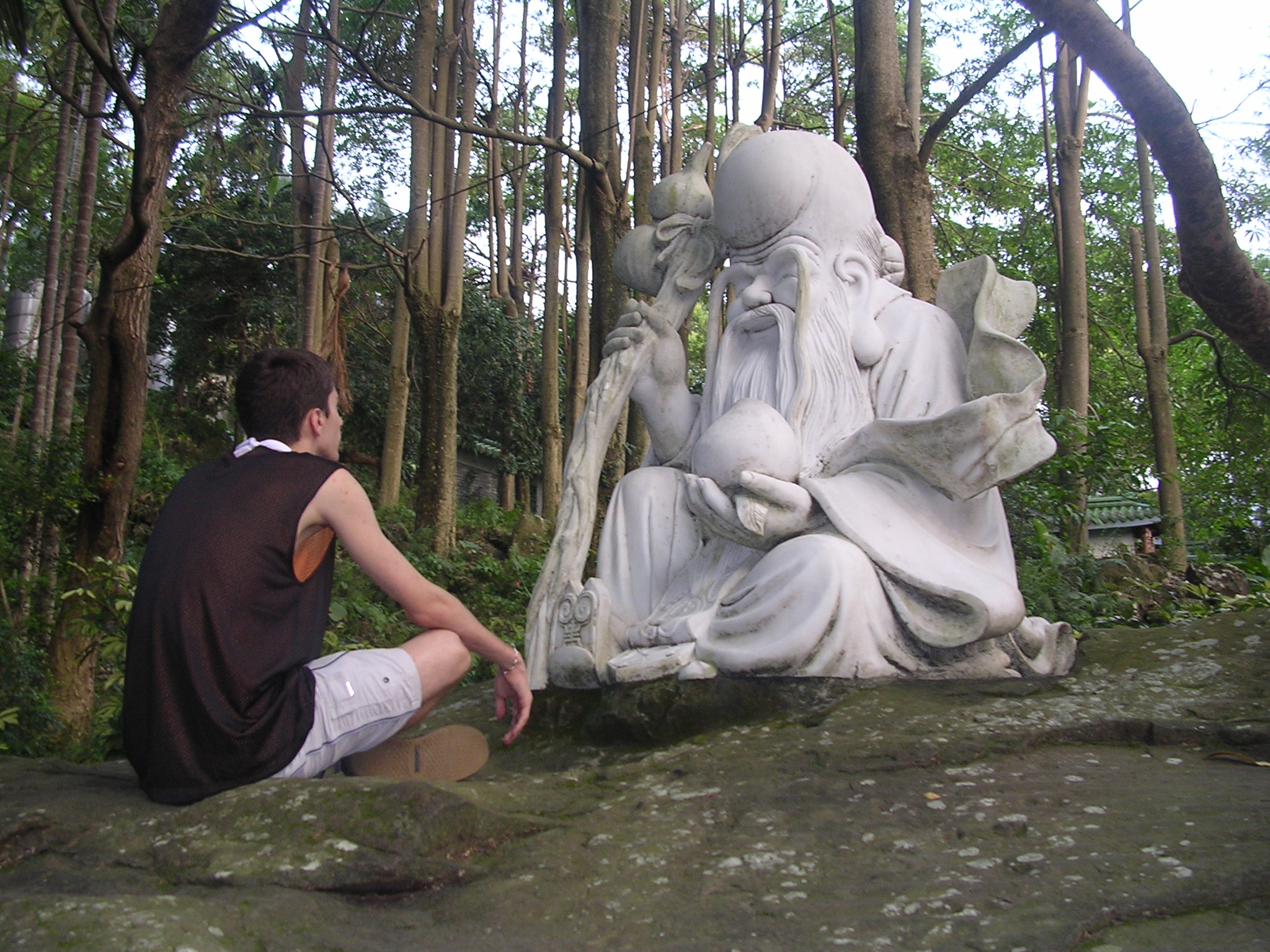 The Buddhist world has seen its fair share of “gurus” and “masters” who introduced “secret meditation techniques” and found instructions nobody had ever seen before because they “allegedly” got lost or distorted over time – only to be (re-)introduced by the new spiritual leader, usually with side effects in favor of the discoverer commonly known as “lābhasakkāra“. But that could not be further from the Buddha’s Dhamma:
The Buddhist world has seen its fair share of “gurus” and “masters” who introduced “secret meditation techniques” and found instructions nobody had ever seen before because they “allegedly” got lost or distorted over time – only to be (re-)introduced by the new spiritual leader, usually with side effects in favor of the discoverer commonly known as “lābhasakkāra“. But that could not be further from the Buddha’s Dhamma:
Buddha: ” Now, Siha, make a proper investigation. Proper investigation is good in the case of well-known men like yourself.””
General Siha: “I, Lord, am even exceedingly pleased, satisfied with that which the Lord said to me : ‘ Now, Siha, make a proper investigation . . . like yourself.’ For if. Lord, members of other sects had secured me as a disciple, they would have paraded a banner all round Vesali, saying : ‘ Siha, the general, has joined our disciplehood.'”
Buddha: For a long time, Siha, your family has been a well-spring to the Niganthas (Jains). You will bethink you to give alms to those who approach you ? ”
General Siha: ” I, Lord, am even exceedingly pleased, satisfied with that which the Lord said to me : ‘ For a long time, Siha, your family . . . those who approach you ? ‘ I have heard, Lord : The recluse Gotama speaks thus : ‘ Gifts should be given, to me only, not to others should gifts be given ; gifts should be given to my disciples only, not to the disciples of others should gifts be given. What is given to me is alone of great fruit, what is given to others is not of great fruit ; what is given to my disciples is alone of great fruit, what is given to the disciples of others is not of great fruit.’ But then the Lord urged upon me giving to the Niganthas too. Indeed, Lord, we shall know the right time for that. So I, Lord, go for a third time to the Lord for refuge and to dhamma and to the Order of monks. May the Lord accept me as a layfollower going for refuge from this day forth for as long as life lasts.” [1]
The idea of such a secretive teaching – only open to the initiated – is truly missing from the picture the suttas paint of the time when the Dhamma was taught by the Buddha himself – and no matter how excited you might be about modern mainstream Buddhism – once you familiarize yourself with only a few original discourses of the Buddha – you will immediately start to see and feel that incredible rational, carefully questioning, personally investigative teaching which makes modern interpretations of Buddhism sometimes seem wildly out of touch – not just with reality but indeed, with the most ancient form of Buddhism. The teaching we can study in the ancient discourses of the Buddha will probably remind you of … wait a second! … some kind of scientific methodology in analysing life and then again some kind of pragmatic engineering practice when it comes to solving the mind-body machinery’s suffering. But I am getting off topic 😉
Back to the topic: For anyone still searching for the “lost key” or “secret passageway to Nirvana” I highly recommend a look at the following extremely “mundane” discussion between two senior disciples of the Buddha as recorded and passed down in the Pali Canon, at least 300 BC:
[Anuruddha & Sariputta discuss meditation]
Anuruddha: “Brother Sariputta with the divine eye, which is clarified and supernormal, I am able to perceive a thousandfold world system. My energy is strong and inflexible; my remembrance is alert and unforgetful; my body is calmed and unexcited; my mind is collected and unified. Yet my mind is still not freed, without clinging, from the defiling taints (asava).”
Thereupon Sariputta replied: “When you think, brother Anuruddha, that with your divine eye you can perceive a thousandfold world system, that is self-conceit in you. When you think of your strenuous energy, your alert mindfulness, your calmed body and your concentrated mind, that is agitation in you. When you think that your mind is still not liberated from the cankers, that makes for scruples in you. It will be good if the revered Anuruddha would discard these three things, would not pay attention to them and would instead direct his mind towards the Deathless-element (Nibbana).”
Having heard Sariputta’s advice, Anuruddha again resorted to solitude and earnestly applied himself to the removal of those three obstructions within his mind (AN 3:128), more: Wheel 262, BPS.
 This passage is remarkable (besides the fact that it haunted me for the last 20 years). I cannot remember how many times it came up when I had discussions about progress in meditation with various friends and students. But just recently it hit me that what we see in this episode and which I was most consciously unaware of is the fact this itself, is a documented case of someone seeking and receiving (!) meditation instructions at the time of the Buddha.
This passage is remarkable (besides the fact that it haunted me for the last 20 years). I cannot remember how many times it came up when I had discussions about progress in meditation with various friends and students. But just recently it hit me that what we see in this episode and which I was most consciously unaware of is the fact this itself, is a documented case of someone seeking and receiving (!) meditation instructions at the time of the Buddha.
It may or may not be such a novel thought for you. But please take some time and really think about it. There is something truly remarkable about the fact that we get a direct peek into the (typical?) way meditation interviews where conducted at the time of the Buddha. Now, there are arguably many more similar instances (Buddha giving Rahula instructions, monks coming to the Buddha asking for personal instructions etc.) but in many of those cases it could be argued that they serve the purpose of a more philosophical discussion than literal instructions on meditation practice. Such a case is really hard to make when you read the above exchange between Sariputta and Anuruddha. There seems to be no other way you can take this as just what it is: a meditation interview.
In this short sutta, there is nothing real philosophical. The style is prosaic, no-nonsensical, non-mystical, pragmatic in its approach regarding the discussion of meditation obstacles. Its prosaic direct style is similar to other sutta passages but here clearly no philosophy is discussed. What Sariputta says is exactly what he means. He takes in Anuruddha’s problem and gives him an advice. Their topic is pretty serious. We can be sure that if this text was transmitted correctly, Sariputta does not just make a joke. His meditation advice which to us might sound “ZEN” style is probably exactly how meditation interviews were conducted at the time of the Buddha. It probably also show us that pointing out hindrances and trying to get rid of them was mentioned and applied in exactly the very same manner. You DID exactly what you HEARD and there was no “secret silver bullet” in between the two. Some secretly transmitted extra layer of instruction which is now lost forever. This will also explain why people nowadays are so confused about “missing” jhana instructions when they are, literally, all over the place staring the reader in their eyes – but unfortunately not in a format which lends itself to a modern reader lacking the mindset (or context) of the Pali texts. This would be the perfect job for a generation of new translators!
This should seriously give us to think. If we were to interpret this episode as indeed to be a record of how a “typical” meditation instruction went down, then this would unlock a lot of other parts in the canon. Passages which would then have to be read in the very same way straight forward (non-commentarial) way: i.e. at face value, making the search for some “hidden” or “newly to be developed” meditation system unnecessary or even questionable (at least if you take the Buddha-Dhamma as your teacher, that is). It should also trigger our inquisitive nature into “trying out sutta practices” which before we just looked at as “spectators” – not realizing that what we read are actual DIY instructions.
So Venerable Anuruddha, obviously at this point quite knowledgeable in the fourth jhana and experienced in directing his mind (abhininnāmeti) towards some, let’s say “special skills” born out of the power of a very concentrated mind, struggles with the part for which he undertook his training – Nirvana – and is puzzled why the very path (which is as such described in numerous suttas all over the tipitaka) that lead him to the fourth jhana and such exalted mental powers – does not automatically lead to Nirvana.
Consider another important observation: The way Ven. Anuruddha is displayed in this text (including Ven. Sariputta) borders on the comical. The text has no problem to depict these Buddhist icons in such a struggling human way – which is very encouraging as to its authenticity and in stark contrast to commentarial exaggerations like Buddhaghosa’s hard-to-digest Dhammapada hagiography. Instead here we have one practitioner who was able to replicate an experiment (=Sariputta) and another stops by to ask why his perfect setup is failing (=Anuruddha). He is then told that he is too worried or taken in by his own experiential setup and that he should not lose sight of the main goal over the side-effects of his operation.
 But unlike later Mahayana sources which enjoyed outright ridiculing Sariputta (cf. Lankāvatara….) as the pinnacle of Arahant-wisdom – in this present old Indian record the story is short, unembellished, getting to the point, recording a valuable lesson which helped Anuruddha accomplish the highest goal for which the Buddha actually started teaching: Nirvana.
But unlike later Mahayana sources which enjoyed outright ridiculing Sariputta (cf. Lankāvatara….) as the pinnacle of Arahant-wisdom – in this present old Indian record the story is short, unembellished, getting to the point, recording a valuable lesson which helped Anuruddha accomplish the highest goal for which the Buddha actually started teaching: Nirvana.
If this is a meditation interview, you should seriously consider and think about the Gelañña Sutta in the Samyutta Nikaya. If you ever wondered what a meditation instruction from the Buddha would look like when you could go and visit him with a time machine, or when the Buddha would give a 10 day retreat and explain the exercises: The Gelañña Sutta sutta should prepare you well enough and leave nothing to wish for – even without a time machine. Well, in a certain way, it IS a time machine…
Surely, all of the above (especially after reading the Gelanna Sutta) raises the question (again) of how contemplation played part in the meditation techniques at the time of the Buddha, how all of the above is related to “sati” (remembrance, aka ‘mindfulness’) and memory in general as well as “thinking and reflecting” as “vitakka vicara” as a tool for increased mindfulness and how its intrinsic connection with the experience of jhanic bliss, happiness and calmness is bound so much more holistically to the development of insight when compared to the current (bluntly mechanical) mainstream Theravada practices of vipassana (with a few exceptions of course, here and there).
Consider this:
Sitting down, closing your eyes, the meditation on Anapana-sati according to the sixteen steps outlined by the Buddha is a case in point. If you start at the beginning 😉 the exercise is pretty clear: From the outline describing how you should sit and observe the breathing carefully – the exercise is clear. For the pure novice, it will likely take weeks/months to pass beyond this point. For the experienced meditator it will take only seconds to a few minutes until his mind’s continuous observation falls into a lock-step with the inhaling and exhaling. Automatically – as a necessity – the fully continued awareness of the breathing process will lead to a heightened awareness of all the subtleties in the breathing process.
So far the first two steps happen naturally and just require training. They are logical, inviting for self-investigation (ehi-passiko) one of the principles of the Dhamma and can be affirmed by anyone who ever gave it a try (paccattam veditabbo viññūhi).
After that the Buddha’s exposition in the Anapanasati sutta switches from a passive (relative – it still needs a lot of skillful exercising to achieve this) observation (pajāṇāti) to a very active approach: in Pali the Buddha now has the meditator “train himself” (sikkhati) to feel the whole body while breathing and then calm down the activity of the body (which manifests itself to the meditator quite clearly as the breathing ) – the more he calms down his breathing, the stiller the mind. This is similar to the idea of a surfer standing on a surf board, highly aware of his posture, board and waves, maybe in an intuitive way if he is very skilled – but the effect is the same: while the surfer stays on the board, the meditator stays with full awareness on his breathing, body and relaxed and calm mind … at that point it is just a question of time (and usually not very long) that mental elation, bliss, pīti comes into the picture -which again the exposition of the Buddha explains as the next stage in sutta on breathing meditation.
Thus here in the Anapanasati Sutta too we find clear meditation instructions which have only one (well maybe more than that, but mainly one) big hindrance to be recognized as such: the clarity of the translator to recognize the instruction as such and phrase it in such a modern equivalent way so as to make it recognizable to be a pragmatic instruction and not a “philosophic discussion”. As you may have guessed, this works best when your experience backs your translation effort. To this end, it would probably be easier if you’d walk into a bookstore and found 50 different translations of the Middle Length sayings – such a competition would probably drive the investigation and deep analysis of the Buddhist texts which – being what they are – is mostly going to benefit their practical application and will less result in theological hair-splitting (as revelation based religions are in danger of).
Unfortunately we do not have such a variety of translation efforts (yet) but that might change in the future. The main situation to keep in mind is that in the current environment it is important to remember the amazing clarity the original texts preserve while at the same time centrifugal forces of entropy (whether through Western cultural nihilism or Eastern monastic hedonism ;-)) make it easier for us to miss the simple, straightforward, highly pragmatic core teachings of the Buddha.[2]
 Therefore: I highly suggest to carefully read about the experiment from those who actually succeeded in it (before all others who had an easy time repeating empty words). One example: Reading the Theragatha or Therigatha can reveal a host of information from a very pragmatic side. Just one quick example: the never ending discussion how to interpret the jhanas is beautifully captured by “first hand” experiences like this one and are a wonderful record to compare against your own experience:
Therefore: I highly suggest to carefully read about the experiment from those who actually succeeded in it (before all others who had an easy time repeating empty words). One example: Reading the Theragatha or Therigatha can reveal a host of information from a very pragmatic side. Just one quick example: the never ending discussion how to interpret the jhanas is beautifully captured by “first hand” experiences like this one and are a wonderful record to compare against your own experience:
Lahuko vata me kayo phuttho ca pltisukhena vipulena
Tulamiva eritam malutena, pilavativa me kayo”ti
Light, varily, feels my body filled with joy and bliss
Like a cotton ball carried by the breeze, floating… [Thag 1.399]
When you read how the first generation of “investigators” (savakas, i.e. listening (sic!) students) carefully replicated the path in themselves with tremendous success try to take most of their meditation records (can’t avoid that historical entropy and noise in any communication) so literal that your personal investigation will lead you to find out what produces the very same results and what does not. It is only logical that for you to succeed in this, you have to know the path well enough before attempting to walk it. Provided such knowledge and paired with a determined pragmatic mindset you will sooner than later see the path re-appear by itself.[3]
===============
[1]‘‘Dīgharattaṃ kho te, sīha, nigaṇṭhānaṃ opānabhūtaṃ kulaṃ, yena nesaṃ upagatānaṃ piṇḍakaṃ dātabbaṃ maññeyyāsī’’ti. ‘‘Imināpāhaṃ, bhante, bhagavato bhiyyosomattāya attamano abhiraddho, yaṃ maṃ bhagavā evamāha – ‘dīgharattaṃ kho te, sīha, nigaṇṭhānaṃ opānabhūtaṃ kulaṃ, yena nesaṃ upagatānaṃ piṇḍakaṃ dātabbaṃ maññeyyāsī’ti. Sutaṃ me taṃ, bhante, samaṇo gotamo evamāha – ‘mayhameva dānaṃ dātabbaṃ, na aññesaṃ dānaṃ dātabbaṃ; mayhameva sāvakānaṃ dānaṃ dātabbaṃ, na aññesaṃ sāvakānaṃ dānaṃ dātabbaṃ; mayhameva dinnaṃ mahapphalaṃ, na aññesaṃ dinnaṃ mahapphalaṃ; mayhameva sāvakānaṃ dinnaṃ mahapphalaṃ, na aññesaṃ sāvakānaṃ dinnaṃ mahapphala’nti. Atha ca pana maṃ bhagavā nigaṇṭhesupi dāne samādapeti. [Mahavagga, Vinaya Pitaka]
[2] Simile: Imagine Einstein discovered the Relativity Theory and everyone becomes so fascinated by the term “relativity” itself that they start writing books about the “relativity” of the color red on the back of a ladybug. While that’s experiental as well, and has something to do with “relativity”, it’s not what Einstein meant. Yes, you are laughing, what an absurd idea. But that is what happened to some very popular interpretations of Buddhism in the West. Take the term “interconnectivity” as a wild (and completely out of context) speculation on paticca samuppada. Similarly, in the days of the Buddha we meet – in the suttas – a generation of lay people and renunciants who, carefully investigating the Buddha’s “theory” of Dhamma by trying to replicate his experiment of “Awakening” carefully re-build his set of instruments, i.e. the noble eightfold path. We can witness and admire their entire honest, humble and utterly critical investigation into the truth the Buddha discovered – and it is sad, that still to this day, many Buddhist’s have such little exposure to the original discourses of the Buddha.
[3] Hoti so, āvuso, samayo yaṃ taṃ cittaṃ ajjhattameva santiṭṭhati sannisīdati ekodi hoti samādhiyati. Tassa maggo sañjāyati. So taṃ maggaṃ āsevati bhāveti bahulīkaroti. Tassa taṃ maggaṃ āsevato bhāvayato bahulīkaroto saṃyojanāni pahīyanti, anusayā byantīhonti. [AN IV, Patipada Vaggo. Yuganaddha Sutta]



David Stringer
You are so right about many modern Western Buddhists not seeing the Buddha’s real actual teachings, and getting some terrible advice re NOT doing Jhana into the bargain. There is an extremely detailed essay by Bhikkhu Sujato called “A History of Mindfulness” you may wish to download (if you haven’t already), where he explores and compares multiple early texts on the Maha Satipatthana Sutra. Fascinating reading for any Buddhist practising both Jhana and Insight. BTW good to have you back online after a long break?
dhamma2553
Yes, a terrifi article. The difficulties of translation of any terminologically precise language is at times overwhelming. Pali is beautifully supple and precise, but translation sometimes misses the point of Suttas. The first two verses of the Dhammapada (Yamakavaggo) recently illustrated this problem for me. They are often translated as a struggle between “good” and “evil,” which once may have had some moral function as a social lesson. But reading the text more directly, reveals it to be much more about the primacy of the cognitive rational faculty (mano) in assessing data (dhamma) – so, you happen to things, your mind-state directs the “action,” not the other way around. But this requires straightening the mind, so that things will be clear, and functioning will be easier than if the mind is twisted, or out of shape – if you put the cart before the horse, so to speak. “Good and evil” are distracting concepts that overwhelm the lesson. A more literal view of the text reveals its incredible psychological insight. It could be something from a modern psych/therapy text! Yet, poor translation buries the non-moralistic precision of the Buddha’s dhamma – and its relevance to us moderns, obsessed with mind and consciousness, their meaning and location.
On the mundane level, in the first verse, the trans. usually talks about an ox pulling a cart, but in the Pali, there is only a footstep (padam); not an ox in sight! Tradition alone has created this metaphoric animal. It is a person pulling a cart, which makes more poetic sense. It is our own painful kammic baggage that drags behind us as the kammic wheel, that follows our misplaced footsteps if the mind is wrongly programmed – or tries to function with “corrupted” data (paduṭṭhena). There are many resources to assist translation and make comparisons to bring out the clearer meaning, such as Access to Insight, and the Digital Pali reader. Both help with translation for the non-scholar.
zurizeno
Hi there! I just discovered your blog, and I am currently reading the Posts, your explanations really were the “click” I was searching for, especially the translation insights, now everything makes a lot more sense, the meditation instructions are clear (But Non-trivial!), and got motivated, im also learning a little pali by osmosis. Thanks!!